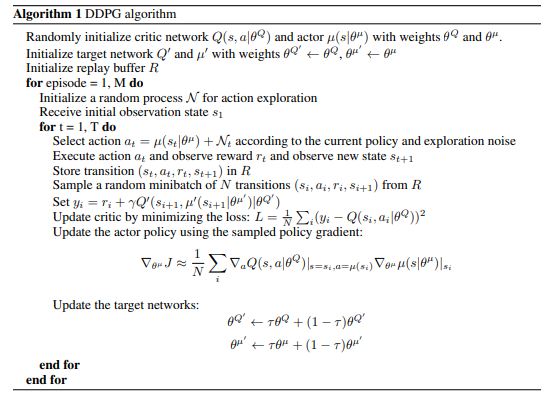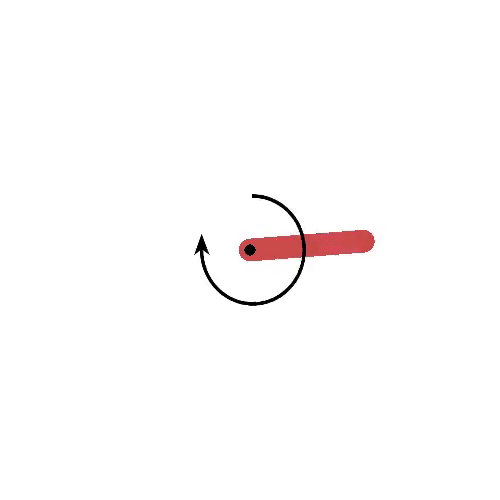Deep Deterministic Policy Gradient (DDPG)
- Original Link : https://keras.io/examples/rl/ddpg_pendulum/
- Last Checked at : 2024-11-23
Author: amifunny
Date created: 2020/06/04
Last modified: 2024/03/23
Description: Implementing DDPG algorithm on the Inverted Pendulum Problem.
Introduction
Deep Deterministic Policy Gradient (DDPG) is a model-free off-policy algorithm for learning continuous actions.
It combines ideas from DPG (Deterministic Policy Gradient) and DQN (Deep Q-Network). It uses Experience Replay and slow-learning target networks from DQN, and it is based on DPG, which can operate over continuous action spaces.
This tutorial closely follow this paper - Continuous control with deep reinforcement learning
Problem
We are trying to solve the classic Inverted Pendulum control problem. In this setting, we can take only two actions: swing left or swing right.
What make this problem challenging for Q-Learning Algorithms is that actions are continuous instead of being discrete. That is, instead of using two discrete actions like -1 or +1, we have to select from infinite actions ranging from -2 to +2.
Quick theory
Just like the Actor-Critic method, we have two networks:
- Actor - It proposes an action given a state.
- Critic - It predicts if the action is good (positive value) or bad (negative value) given a state and an action.
DDPG uses two more techniques not present in the original DQN:
First, it uses two Target networks.
Why? Because it add stability to training. In short, we are learning from estimated targets and Target networks are updated slowly, hence keeping our estimated targets stable.
Conceptually, this is like saying, “I have an idea of how to play this well, I’m going to try it out for a bit until I find something better”, as opposed to saying “I’m going to re-learn how to play this entire game after every move”. See this StackOverflow answer.
Second, it uses Experience Replay.
We store list of tuples (state, action, reward, next_state), and instead of learning only from recent experience, we learn from sampling all of our experience accumulated so far.
Now, let’s see how is it implemented.
import os
os.environ["KERAS_BACKEND"] = "tensorflow"
import keras
from keras import layers
import tensorflow as tf
import gymnasium as gym
import numpy as np
import matplotlib.pyplot as pltWe use Gymnasium to create the environment. We will use the upper_bound parameter to scale our actions later.
# Specify the `render_mode` parameter to show the attempts of the agent in a pop up window.
env = gym.make("Pendulum-v1", render_mode="human")
num_states = env.observation_space.shape[0]
print("Size of State Space -> {}".format(num_states))
num_actions = env.action_space.shape[0]
print("Size of Action Space -> {}".format(num_actions))
upper_bound = env.action_space.high[0]
lower_bound = env.action_space.low[0]
print("Max Value of Action -> {}".format(upper_bound))
print("Min Value of Action -> {}".format(lower_bound))Result
Size of State Space -> 3
Size of Action Space -> 1
Max Value of Action -> 2.0
Min Value of Action -> -2.0To implement better exploration by the Actor network, we use noisy perturbations, specifically an Ornstein-Uhlenbeck process for generating noise, as described in the paper. It samples noise from a correlated normal distribution.
class OUActionNoise:
def __init__(self, mean, std_deviation, theta=0.15, dt=1e-2, x_initial=None):
self.theta = theta
self.mean = mean
self.std_dev = std_deviation
self.dt = dt
self.x_initial = x_initial
self.reset()
def __call__(self):
# Formula taken from https://www.wikipedia.org/wiki/Ornstein-Uhlenbeck_process
x = (
self.x_prev
+ self.theta * (self.mean - self.x_prev) * self.dt
+ self.std_dev * np.sqrt(self.dt) * np.random.normal(size=self.mean.shape)
)
# Store x into x_prev
# Makes next noise dependent on current one
self.x_prev = x
return x
def reset(self):
if self.x_initial is not None:
self.x_prev = self.x_initial
else:
self.x_prev = np.zeros_like(self.mean)The Buffer class implements Experience Replay.
Algorithm

Critic loss - Mean Squared Error of y - Q(s, a) where y is the expected return as seen by the Target network, and Q(s, a) is action value predicted by the Critic network. y is a moving target that the critic model tries to achieve; we make this target stable by updating the Target model slowly.
Actor loss - This is computed using the mean of the value given by the Critic network for the actions taken by the Actor network. We seek to maximize this quantity.
Hence we update the Actor network so that it produces actions that get the maximum predicted value as seen by the Critic, for a given state.
class Buffer:
def __init__(self, buffer_capacity=100000, batch_size=64):
# Number of "experiences" to store at max
self.buffer_capacity = buffer_capacity
# Num of tuples to train on.
self.batch_size = batch_size
# Its tells us num of times record() was called.
self.buffer_counter = 0
# Instead of list of tuples as the exp.replay concept go
# We use different np.arrays for each tuple element
self.state_buffer = np.zeros((self.buffer_capacity, num_states))
self.action_buffer = np.zeros((self.buffer_capacity, num_actions))
self.reward_buffer = np.zeros((self.buffer_capacity, 1))
self.next_state_buffer = np.zeros((self.buffer_capacity, num_states))
# Takes (s,a,r,s') observation tuple as input
def record(self, obs_tuple):
# Set index to zero if buffer_capacity is exceeded,
# replacing old records
index = self.buffer_counter % self.buffer_capacity
self.state_buffer[index] = obs_tuple[0]
self.action_buffer[index] = obs_tuple[1]
self.reward_buffer[index] = obs_tuple[2]
self.next_state_buffer[index] = obs_tuple[3]
self.buffer_counter += 1
# Eager execution is turned on by default in TensorFlow 2. Decorating with tf.function allows
# TensorFlow to build a static graph out of the logic and computations in our function.
# This provides a large speed up for blocks of code that contain many small TensorFlow operations such as this one.
@tf.function
def update(
self,
state_batch,
action_batch,
reward_batch,
next_state_batch,
):
# Training and updating Actor & Critic networks.
# See Pseudo Code.
with tf.GradientTape() as tape:
target_actions = target_actor(next_state_batch, training=True)
y = reward_batch + gamma * target_critic(
[next_state_batch, target_actions], training=True
)
critic_value = critic_model([state_batch, action_batch], training=True)
critic_loss = keras.ops.mean(keras.ops.square(y - critic_value))
critic_grad = tape.gradient(critic_loss, critic_model.trainable_variables)
critic_optimizer.apply_gradients(
zip(critic_grad, critic_model.trainable_variables)
)
with tf.GradientTape() as tape:
actions = actor_model(state_batch, training=True)
critic_value = critic_model([state_batch, actions], training=True)
# Used `-value` as we want to maximize the value given
# by the critic for our actions
actor_loss = -keras.ops.mean(critic_value)
actor_grad = tape.gradient(actor_loss, actor_model.trainable_variables)
actor_optimizer.apply_gradients(
zip(actor_grad, actor_model.trainable_variables)
)
# We compute the loss and update parameters
def learn(self):
# Get sampling range
record_range = min(self.buffer_counter, self.buffer_capacity)
# Randomly sample indices
batch_indices = np.random.choice(record_range, self.batch_size)
# Convert to tensors
state_batch = keras.ops.convert_to_tensor(self.state_buffer[batch_indices])
action_batch = keras.ops.convert_to_tensor(self.action_buffer[batch_indices])
reward_batch = keras.ops.convert_to_tensor(self.reward_buffer[batch_indices])
reward_batch = keras.ops.cast(reward_batch, dtype="float32")
next_state_batch = keras.ops.convert_to_tensor(
self.next_state_buffer[batch_indices]
)
self.update(state_batch, action_batch, reward_batch, next_state_batch)
# This update target parameters slowly
# Based on rate `tau`, which is much less than one.
def update_target(target, original, tau):
target_weights = target.get_weights()
original_weights = original.get_weights()
for i in range(len(target_weights)):
target_weights[i] = original_weights[i] * tau + target_weights[i] * (1 - tau)
target.set_weights(target_weights)Here we define the Actor and Critic networks. These are basic Dense models with ReLU activation.
Note: We need the initialization for last layer of the Actor to be between -0.003 and 0.003 as this prevents us from getting 1 or -1 output values in the initial stages, which would squash our gradients to zero, as we use the tanh activation.
def get_actor():
# Initialize weights between -3e-3 and 3-e3
last_init = keras.initializers.RandomUniform(minval=-0.003, maxval=0.003)
inputs = layers.Input(shape=(num_states,))
out = layers.Dense(256, activation="relu")(inputs)
out = layers.Dense(256, activation="relu")(out)
outputs = layers.Dense(1, activation="tanh", kernel_initializer=last_init)(out)
# Our upper bound is 2.0 for Pendulum.
outputs = outputs * upper_bound
model = keras.Model(inputs, outputs)
return model
def get_critic():
# State as input
state_input = layers.Input(shape=(num_states,))
state_out = layers.Dense(16, activation="relu")(state_input)
state_out = layers.Dense(32, activation="relu")(state_out)
# Action as input
action_input = layers.Input(shape=(num_actions,))
action_out = layers.Dense(32, activation="relu")(action_input)
# Both are passed through separate layer before concatenating
concat = layers.Concatenate()([state_out, action_out])
out = layers.Dense(256, activation="relu")(concat)
out = layers.Dense(256, activation="relu")(out)
outputs = layers.Dense(1)(out)
# Outputs single value for give state-action
model = keras.Model([state_input, action_input], outputs)
return modelpolicy() returns an action sampled from our Actor network plus some noise for exploration.
def policy(state, noise_object):
sampled_actions = keras.ops.squeeze(actor_model(state))
noise = noise_object()
# Adding noise to action
sampled_actions = sampled_actions.numpy() + noise
# We make sure action is within bounds
legal_action = np.clip(sampled_actions, lower_bound, upper_bound)
return [np.squeeze(legal_action)]Training hyperparameters
std_dev = 0.2
ou_noise = OUActionNoise(mean=np.zeros(1), std_deviation=float(std_dev) * np.ones(1))
actor_model = get_actor()
critic_model = get_critic()
target_actor = get_actor()
target_critic = get_critic()
# Making the weights equal initially
target_actor.set_weights(actor_model.get_weights())
target_critic.set_weights(critic_model.get_weights())
# Learning rate for actor-critic models
critic_lr = 0.002
actor_lr = 0.001
critic_optimizer = keras.optimizers.Adam(critic_lr)
actor_optimizer = keras.optimizers.Adam(actor_lr)
total_episodes = 100
# Discount factor for future rewards
gamma = 0.99
# Used to update target networks
tau = 0.005
buffer = Buffer(50000, 64)Now we implement our main training loop, and iterate over episodes. We sample actions using policy() and train with learn() at each time step, along with updating the Target networks at a rate tau.
# To store reward history of each episode
ep_reward_list = []
# To store average reward history of last few episodes
avg_reward_list = []
# Takes about 4 min to train
for ep in range(total_episodes):
prev_state, _ = env.reset()
episodic_reward = 0
while True:
tf_prev_state = keras.ops.expand_dims(
keras.ops.convert_to_tensor(prev_state), 0
)
action = policy(tf_prev_state, ou_noise)
# Receive state and reward from environment.
state, reward, done, truncated, _ = env.step(action)
buffer.record((prev_state, action, reward, state))
episodic_reward += reward
buffer.learn()
update_target(target_actor, actor_model, tau)
update_target(target_critic, critic_model, tau)
# End this episode when `done` or `truncated` is True
if done or truncated:
break
prev_state = state
ep_reward_list.append(episodic_reward)
# Mean of last 40 episodes
avg_reward = np.mean(ep_reward_list[-40:])
print("Episode * {} * Avg Reward is ==> {}".format(ep, avg_reward))
avg_reward_list.append(avg_reward)
# Plotting graph
# Episodes versus Avg. Rewards
plt.plot(avg_reward_list)
plt.xlabel("Episode")
plt.ylabel("Avg. Episodic Reward")
plt.show()Result
Episode * 0 * Avg Reward is ==> -1020.8244931732263
Episode * 1 * Avg Reward is ==> -1338.2811167733332
Episode * 2 * Avg Reward is ==> -1450.0427316158366
Episode * 3 * Avg Reward is ==> -1529.0751774957375
Episode * 4 * Avg Reward is ==> -1560.3468658090717
Episode * 5 * Avg Reward is ==> -1525.6201906715812
Episode * 6 * Avg Reward is ==> -1522.0047531836371
Episode * 7 * Avg Reward is ==> -1507.4391205141226
Episode * 8 * Avg Reward is ==> -1443.4147334537984
Episode * 9 * Avg Reward is ==> -1452.0432974943765
Episode * 10 * Avg Reward is ==> -1344.1960761302823
Episode * 11 * Avg Reward is ==> -1327.0472948059835
Episode * 12 * Avg Reward is ==> -1332.4638031402194
Episode * 13 * Avg Reward is ==> -1287.4884456842617
Episode * 14 * Avg Reward is ==> -1257.3643575644046
Episode * 15 * Avg Reward is ==> -1210.9679762262906
Episode * 16 * Avg Reward is ==> -1165.8684037899104
Episode * 17 * Avg Reward is ==> -1107.6228192573426
Episode * 18 * Avg Reward is ==> -1049.4192654959388
Episode * 19 * Avg Reward is ==> -1003.3255480245641
Episode * 20 * Avg Reward is ==> -961.6386918013155
Episode * 21 * Avg Reward is ==> -929.1847739440876
Episode * 22 * Avg Reward is ==> -894.356849609832
Episode * 23 * Avg Reward is ==> -872.3450419603026
Episode * 24 * Avg Reward is ==> -842.5992147531034
Episode * 25 * Avg Reward is ==> -818.8730806655396
Episode * 26 * Avg Reward is ==> -793.3147256249664
Episode * 27 * Avg Reward is ==> -769.6124209263007
Episode * 28 * Avg Reward is ==> -747.5122117563488
Episode * 29 * Avg Reward is ==> -726.8111953151997
Episode * 30 * Avg Reward is ==> -707.3781885286952
Episode * 31 * Avg Reward is ==> -688.9993520703357
Episode * 32 * Avg Reward is ==> -672.0164054875188
Episode * 33 * Avg Reward is ==> -652.3297236089893
Episode * 34 * Avg Reward is ==> -633.7305579653394
Episode * 35 * Avg Reward is ==> -622.6444438529929
Episode * 36 * Avg Reward is ==> -612.2391199605028
Episode * 37 * Avg Reward is ==> -599.2441039477458
Episode * 38 * Avg Reward is ==> -593.713500114108
Episode * 39 * Avg Reward is ==> -582.062487157142
Episode * 40 * Avg Reward is ==> -556.559275313473
Episode * 41 * Avg Reward is ==> -518.053376711216
Episode * 42 * Avg Reward is ==> -482.2191305356082
Episode * 43 * Avg Reward is ==> -441.1561293090619
Episode * 44 * Avg Reward is ==> -402.0403515001418
Episode * 45 * Avg Reward is ==> -371.3376110030464
Episode * 46 * Avg Reward is ==> -336.8145387714556
Episode * 47 * Avg Reward is ==> -301.7732070717081
Episode * 48 * Avg Reward is ==> -281.4823965447058
Episode * 49 * Avg Reward is ==> -243.2750024568545
Episode * 50 * Avg Reward is ==> -236.6512197943394
Episode * 51 * Avg Reward is ==> -211.20860968588096
Episode * 52 * Avg Reward is ==> -176.31339260650844
Episode * 53 * Avg Reward is ==> -158.77021134671222
Episode * 54 * Avg Reward is ==> -146.76749516161257
Episode * 55 * Avg Reward is ==> -133.93793525539664
Episode * 56 * Avg Reward is ==> -129.24881351771964
Episode * 57 * Avg Reward is ==> -129.49219614666802
Episode * 58 * Avg Reward is ==> -132.53205721511375
Episode * 59 * Avg Reward is ==> -132.60389802731262
Episode * 60 * Avg Reward is ==> -132.62344822194035
Episode * 61 * Avg Reward is ==> -133.2372468795715
Episode * 62 * Avg Reward is ==> -133.1046546040286
Episode * 63 * Avg Reward is ==> -127.17488349564069
Episode * 64 * Avg Reward is ==> -130.02349725294775
Episode * 65 * Avg Reward is ==> -127.32475296620544
Episode * 66 * Avg Reward is ==> -126.99528350924034
Episode * 67 * Avg Reward is ==> -126.65903554713267
Episode * 68 * Avg Reward is ==> -126.63950221408372
Episode * 69 * Avg Reward is ==> -129.4066259498526
Episode * 70 * Avg Reward is ==> -129.34372109952105
Episode * 71 * Avg Reward is ==> -132.29705860930432
Episode * 72 * Avg Reward is ==> -132.00732697620566
Episode * 73 * Avg Reward is ==> -138.01483877165032
Episode * 74 * Avg Reward is ==> -145.33430273020608
Episode * 75 * Avg Reward is ==> -145.32777005464345
Episode * 76 * Avg Reward is ==> -142.4835146046417
Episode * 77 * Avg Reward is ==> -139.59338840338395
Episode * 78 * Avg Reward is ==> -133.04552232142163
Episode * 79 * Avg Reward is ==> -132.93288588036899
Episode * 80 * Avg Reward is ==> -136.16012471382237
Episode * 81 * Avg Reward is ==> -139.21305348031393
Episode * 82 * Avg Reward is ==> -133.23691621529298
Episode * 83 * Avg Reward is ==> -135.92990594024982
Episode * 84 * Avg Reward is ==> -136.03027429930435
Episode * 85 * Avg Reward is ==> -135.97360824863455
Episode * 86 * Avg Reward is ==> -136.10527880830494
Episode * 87 * Avg Reward is ==> -139.05391439010512
Episode * 88 * Avg Reward is ==> -142.56133171606365
Episode * 89 * Avg Reward is ==> -161.33989090345662
Episode * 90 * Avg Reward is ==> -170.82788477632195
Episode * 91 * Avg Reward is ==> -170.8558841498521
Episode * 92 * Avg Reward is ==> -173.9910213401168
Episode * 93 * Avg Reward is ==> -176.87631595893498
Episode * 94 * Avg Reward is ==> -170.97863292694336
Episode * 95 * Avg Reward is ==> -173.88549953443538
Episode * 96 * Avg Reward is ==> -170.7028462286189
Episode * 97 * Avg Reward is ==> -173.47564018610032
Episode * 98 * Avg Reward is ==> -173.42104867150212
Episode * 99 * Avg Reward is ==> -173.2394285933109
If training proceeds correctly, the average episodic reward will increase with time.
Feel free to try different learning rates, tau values, and architectures for the Actor and Critic networks.
The Inverted Pendulum problem has low complexity, but DDPG work great on many other problems.
Another great environment to try this on is LunarLander-v2 continuous, but it will take more episodes to obtain good results.
# Save the weights
actor_model.save_weights("pendulum_actor.weights.h5")
critic_model.save_weights("pendulum_critic.weights.h5")
target_actor.save_weights("pendulum_target_actor.weights.h5")
target_critic.save_weights("pendulum_target_critic.weights.h5")Before Training:

After 100 episodes:
